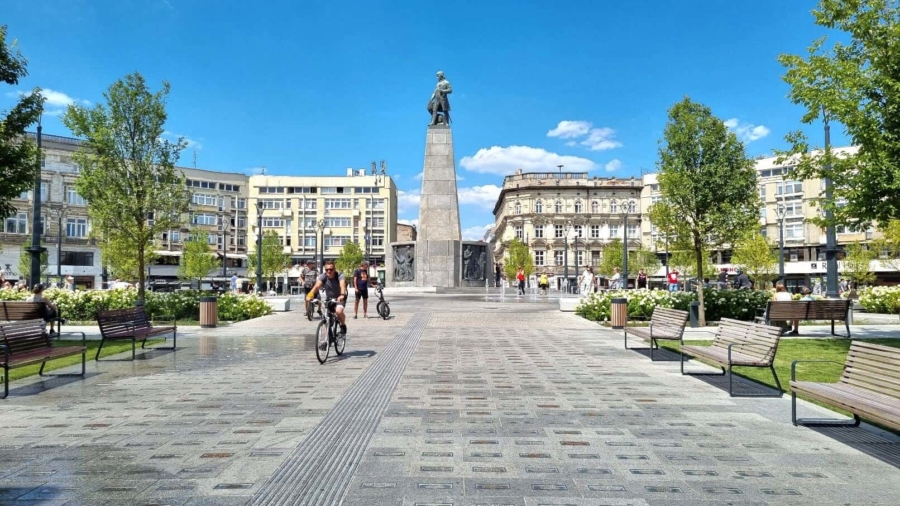These days, visitors to Łódź are understandably drawn to the hustle and bustle of Piotrkowska Street, or the shops, restaurants and leisure facilities at Manufaktura. However, just a little digging online into the main sights in Łódź will surely return results which include the city’s most famous square, Plac Wolności.
It was in February 2024 that the long awaited reconstruction of Plac Wolności (Freedom Square) was completed. With the aid of photographs from a range of angles, this post will show the newly revitalised square in all its glory. Before that, I shall share a brief history of Plac Wolności and, indeed, some of the main buildings on the square.
A Brief History of Plac Wolności in Łódź
In order to appreciate the beginnings of the present day Plac Wolności in Łódź, one needs to go back to 1821-23. To distinguish this square from the previous centre of agricultural Łódź – the Old Town Market Square (Stary Rynek) located approximately 450 metres to the north – the original name of Plac Wolności was Rynek Nowego Miasta – “New Town Market Square”. The New Town Market Square was designated as an octagonal central square of the first cloth settlement in Łódź called Nowe Miasto.
Historical records indicate that the origins of Plac Wolności pre-date industrialism. In the early 1800s, the square was the site of a thriving market. The New Town Market Square was first mapped in the early 1820s. Thereafter, villagers sold their produce from stalls in the centre of the square.
With the mapping of the New Town Market Square, 16 building plots would soon go on sale. The next main section of this post will cover the history and development of the most historically noteworthy buildings and monuments on Plac Wolności in Łódź. Therefore, I’ll only briefly mention them now in this historical overview of the square.
The New Town Market Square in the 1820s
First of all, 1824 is a key year in the history of modern-day Plac Wolności as that was when the first building of note was constructed on the New Town Market Square. That building was a wooden inn, with a tavern, owned by Jan Adamowski.
In 1827, the City Hall building was constructed. After several reconstructions, the City Hall stands to this day in the form of the State Archives in Łódź. In 1828, the Evangelical Church of St. Trinity also sprang up. The author of both projects was Płock-born architect Bonifacy Witkowski.
The New Town Market Square in the second half of the nineteenth century
The first school in Łódź was founded in 1856. Designed by Jan Karol Mertsching, the building originally housed the District Real School, and then the Łódź Craft School.
Located at present-day Plac Wolności 14, the building currently houses the Museum of Archeology and Ethnography.
More information about the building to follow soon.
Trams come to Łódź in 1898
Another event of note to affect the New Town Market Square in the second half of the nineteenth century was the introduction of trams in 1898. This meant that traders who’d previously wheeled and dealed on the square had to relocate.
Initially, trams ran through the middle of the New Town Market Square.
Łódź in the Twentieth Century
Poland regained independence in 1918. As a result, the New Town Market Square was renamed Plac Wolności.
In 1930, a monument to Tadeusz Kościuszko – a Polish military engineer, statesman, and prominent military leader in the late eighteenth century – was erected in the middle of the square. Inevitably, the Nazis demolished the monument (on November 11, 1939). However, the monument was rebuilt in an identical form in 1960.
Present-day Plac Wolności
Alongside entire streets, tenement houses, parks, factories and more, Plac Wolności reaped tremendous benefits from the revitalisation programme that has transformed Łódź in recent years.
Work on the rebuilding of the square commenced in April 2022 and was completed in February 2024.
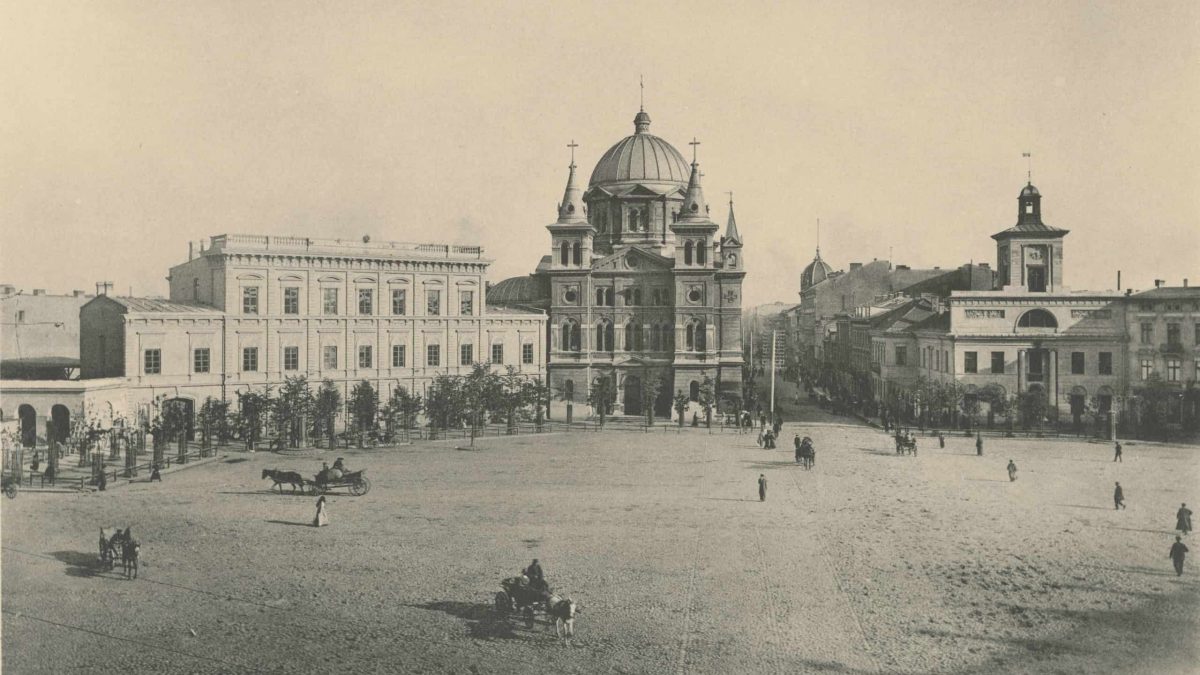

Buildings and Monuments on Plac Wolności in Łódź
There exist a plethora of buildings and monuments on Plac Wolności in Łódź which have significant historical importance and sightseeing value:
Jan Adamowski’s Wooden Inn – Plac Wolności 9
The first plot on the New Town Market Square was bought by a certain Jan Adamowski, a resident of Błonie near Warsaw. From his hometown, Adamowski applied for a permit to sell alcohol in Łódź.
In 1824, Adamowski built a single-storey wooden inn with a tavern. Located at present-day Plac Wolności 9 on the corner with Nowomiejska Street, the building contained hotel rooms, a shop and a tavern-restaurant. The first foreign cloth retailers started coming to Łódź in the early 1820s so the inn gave them a place to spend the night.
Shortly after Adamowski’s wooden inn was built, the local council forbade the construction of wooden and single-storey buildings on the New Town Market Square. This decision may well have resulted from the dislike which the “father of Industrial Łódź”, Rajmund Rembieliński, had of Adamowski’s structurally unsturdy inn. Rembieliński, a Polish nobleman and political activist, wished for the Market Square to be a representative point of the city. Therefore, Rembieliński didn’t hold back from informing the then mayor of Łódź, Antoni Czarkowski, about his feelings.
Miraculously, the Adamowski Inn survived on the square until 1882. A new three-storey tenement house with an attic built for Jakub Kamiński replaced the wooden construction. The tenement house was designed with the intention of using the floors for the needs of a hotel. Built in the eclectic style, the house was called “Under the Lion” (“Pod Lwem”) because a sculpture of a lion graces the corner gable at top of the building.
The tenement house still stands today.
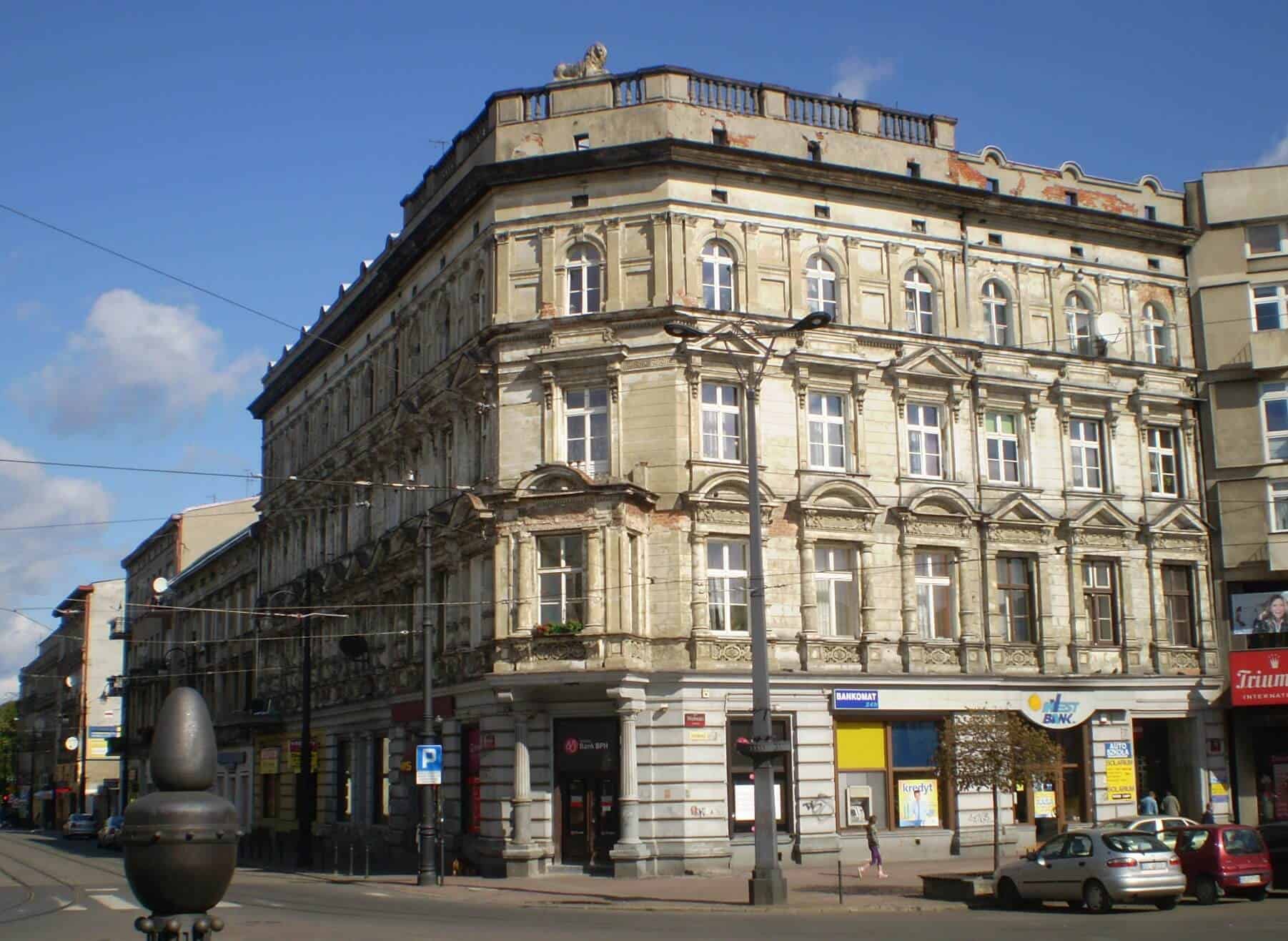
Old City Hall – Stary Ratusz
It was in May 1826 that the authorities of the city of Łódź announced a tender for the construction of a brick city hall building. The winner was a construction entrepreneur from Zgierz, Johann Lebelt, who undertook to construct a new building for 35 thousand zlotys. Krzysztof Wilhelm Dürring, a construction engineer of the Łęczyca district, was the supervisor of proceedings. Bonifacy Witkowski, assistant professor of construction at the Mazovian Voivodeship Commission, designed the building.
The construction of the Old City Hall was completed in 1827, although with numerous shortcomings caused by the June 27 deadline which Lebelt was barely able to meet. Lebelt was charged for failing to fulfil the terms of the contract.
In 1832, a clock tower was added. The clock that was eventually installed on it was a gift from a manufacturer from Ozorków, Fryderyk Schlösser.
For the first three years, the Old Town Hall did not in fact fulfil its intended council-based administrative functions. It was rented to Tytus Kopisch, a manufacturer from Silesia, who manufactured linen products. After Kopisch left in 1830, the city authorities took possession of the building and a major renovation was carried out. Occupying seven rooms, there was an office and apartment of the mayor on the first floor. On the ground floor there was the municipal cash desk, an archive, a guardhouse and the police inspector’s office. There were prison cells In the basement.
According to the design of Jan Karol Mertsching, the City Hall was expanded in the early 1860s by a side wing from Piotrkowska Street.
The town hall underwent another “facelift” in 1888 under the supervision of the city architect of Łódź, Hilary Majewski. Principally, the interiors were thoroughly remodelled. On the first floor, a meeting room was created with an oak floor and decorative walls and ceilings, and the wooden stairs were replaced with marble ones. Moreover, a room for two clock bells was added to the tower. The previously empty triangular space between the town hall and Makysmilian Leinweber’s tenement house at Nowy Rynek 2 was built over. In this way, an additional room was created on the ground floor and the first floor. The staircase in the courtyard was rebuilt, and a balcony was installed on the side of Piotrkowska Street.
In 1914, the first year of World War One, a grenade dropped from a German warplane caused damage to the City Hall. The explosion caused all the windows to fall out along with their frames, while plaster fell off the building’s facade. Moreover, the clock was damaged. Therefore, another renovation had to be carried out in 1915. After this renovation, the building was occupied by the offices of the Tax Department, Health Department and the Department of Population Registers. They remained there until the late 1920s.
In 1915, the city authorities took possession of the building of the Łódź Higher School of Crafts and Industry located at Nowy Rynek 14 and moved their headquarters there. Nevertheless, since the premises of the former school did not meet the needs of the city council, the building was expanded in the years 1924-1925.
In 1927, the City Hall was designated as the Archives of Historical Records of the City of Łódź, which, under a changed name (Archiwum Państwowe w Łodzi – State Archives in Łódź), has been operating there to this day.
After the end of World War II, the city authorities moved to Piotrkowska Street 104 – the palace of Juliusz Heinzel. Established in 1864, this building was initially the said owner’s mechanical weaving mill for woollen goods.
The city hall on Plac Wolności is one of the few monuments of the “golden age” when industrial Łódź was born. It is there that one can observe the very beginnings of Lodz’s heyday. The structure of the city hall has retained its intended Empire style with Renaissance/Classicist elements to this day.
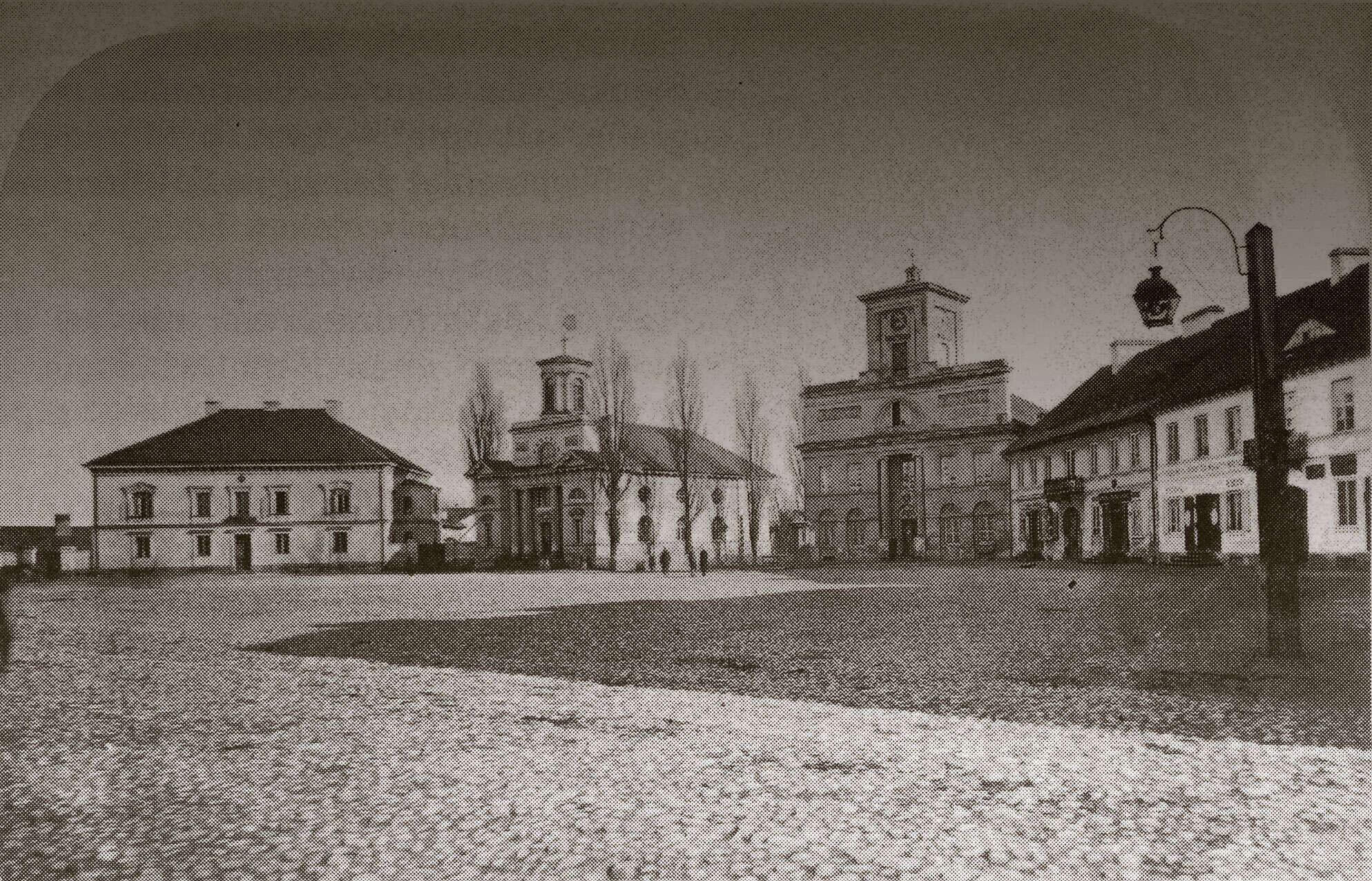
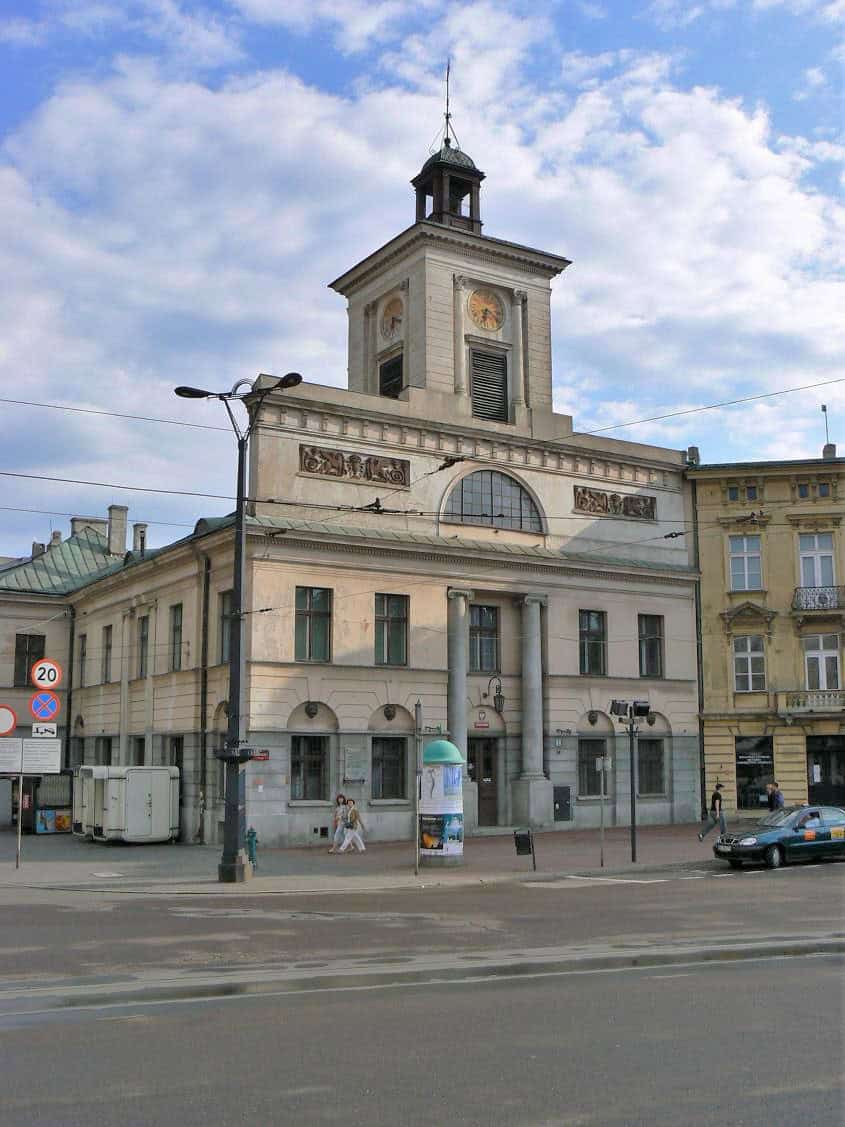
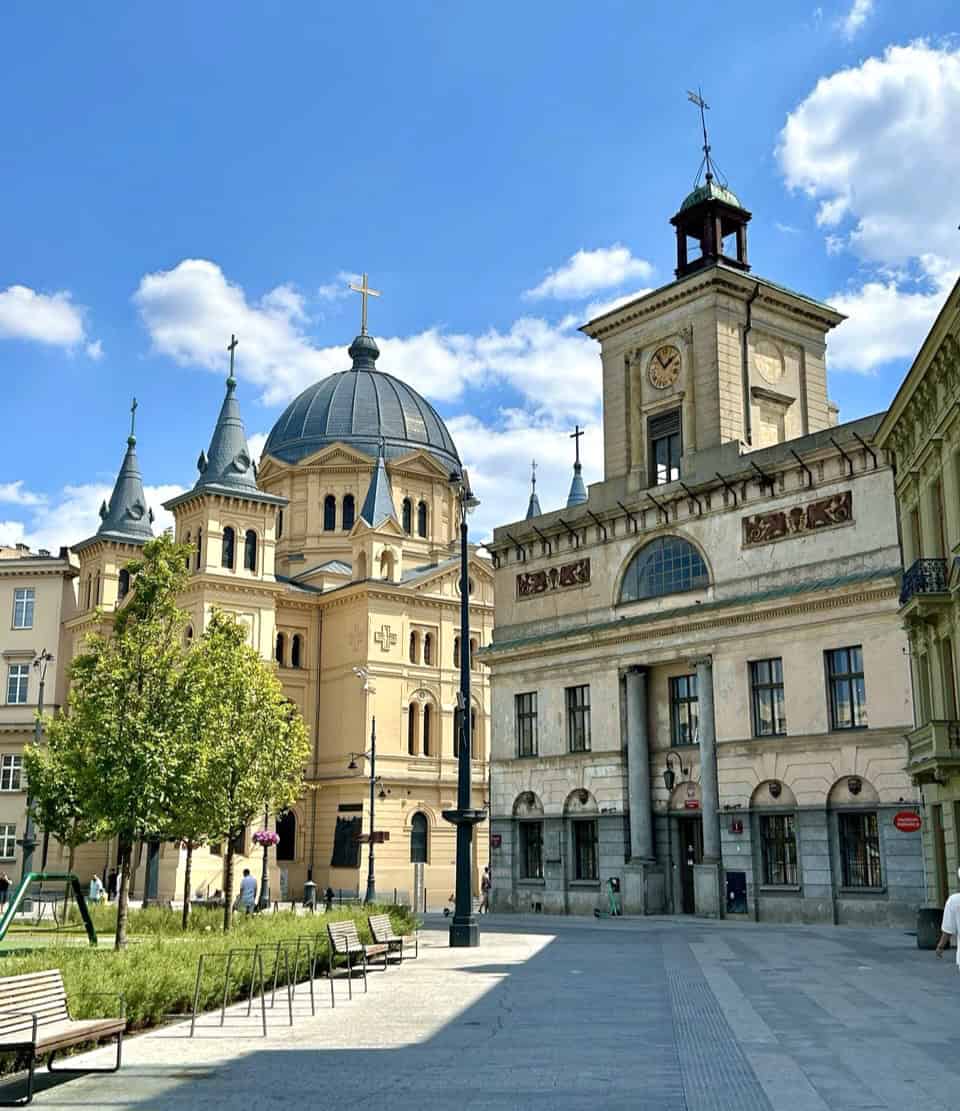
Evangelical Church of the Descent of the Holy Spirit in Łódź
The Construction Committee for the first Evangelical church in Łódź was established in March 1825. Its members included pastor Heinrich Bando from Zgierz, Łódź entrepreneur Christian Wendisch, and merchant Jan Adamowski. On the orders of Rajmund Rembieliński, a site for the church was designated on a corner plot of the New Market Square right next to the Piotrków route (present-day Piotrkowska Street). As previously mentioned, the author of the church design was Bonifacy Witkowski. His aim was to create a building similar to the town hall at the opposite corner of the square.
The pastor’s house was built in February 1827. At the same time, the walls of the church were also standing. However, the rest of the construction work lasted until the end of the following year. The building was consecrated and opened for use only on July 26, 1829. Named after the Holy Trinity, the church was the first brick religious building in Łódź.
Between 1889 and 1892, the original church was torn down and subsequently rebuilt in the neo-Renaissance style. This decision was brought about by the fact that the number of Augsburg Evangelicals (Lutherans) was growing rapidly in Łódź. Therefore, the Parish Council decided to come to the assistance of the second largest religious community in the city. The main architect of the new church was Otto Gehlig, while Hilary Majewski had some input. It was in February 1892 that the new Holy Trinity Church was consecrated.
The church has been a Roman Catholic temple since 1945. In 1948, Bishop Michał Klepacz erected it as the Parish of the Descent of the Holy Spirit.
Finally, the address of the Evangelical Church of the Descent of the Holy Spirit is Piotrkowska Street 2. Therefore, I briefly described the history of the church in my write-up on historical buildings on Piotrkowska Street. However, I’ve gone into a bit more detail this time regarding the history of the church. As far as I can tell, the church has always been more associated with Plac Wolności than Piotrkowska Street.
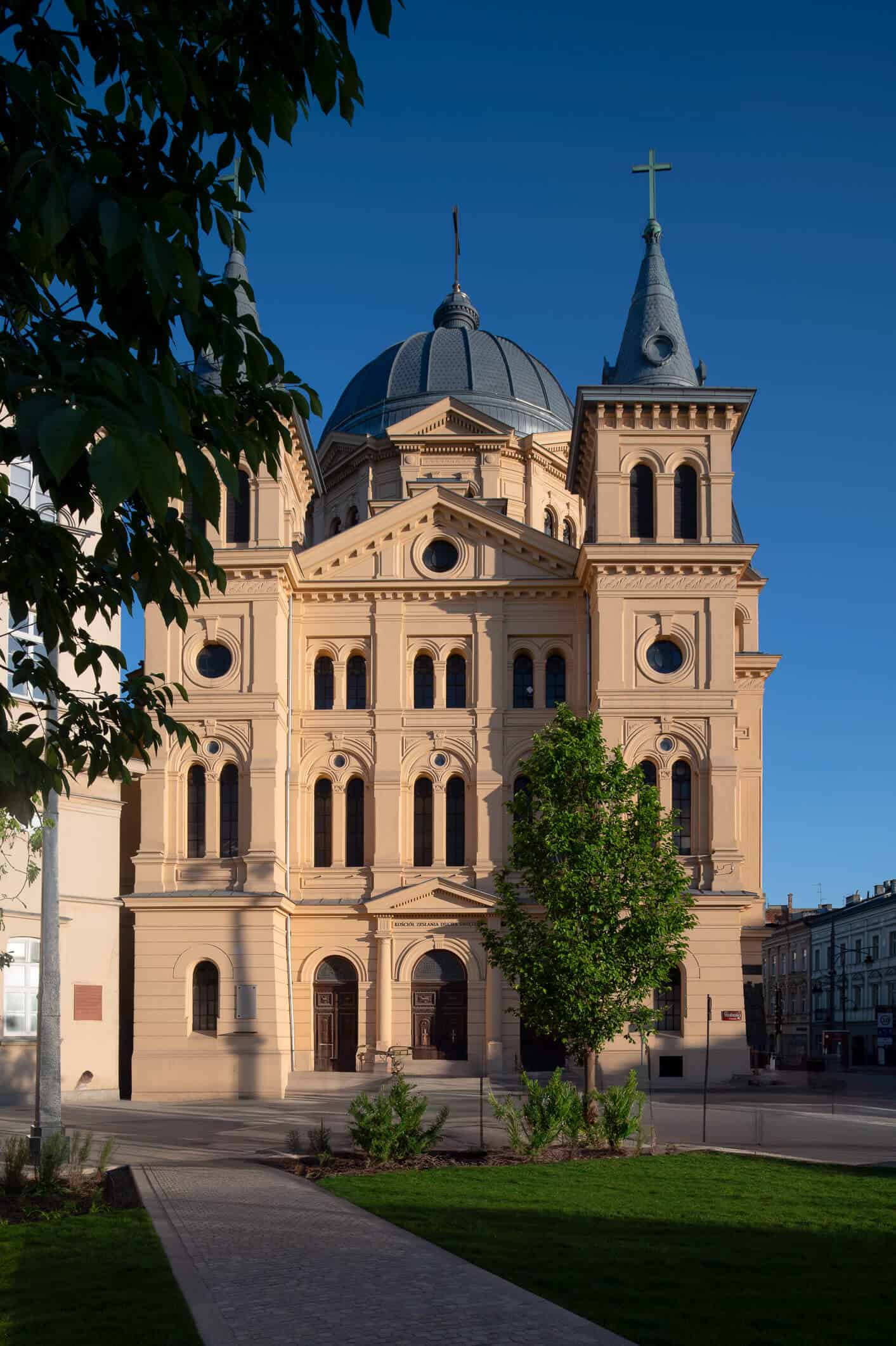
Museum of the History of Pharmacy in Łódź
At the beginning of the 19th century, residents of Łódź had to go all the way to Zgierz to buy their medicines. It was not until 1828 that pharmacist Karol Ketschen applied for a permit to open the first pharmacy in Łódź. He received it, but it took him two years to prepare the pharmacy for opening. Initially, the pharmacy was located in a rented room in the building at what was then Plac Wolności 2, but is now the tenement house at number 7.
In 1840, the pharmacy’s next owner, Bogumił (Gottlieb) Zimmermann moved the pharmacy to a newly built tenement house at present-day Plac Wolności 2, directly next to the Old City Hall.
In 1893, according to the design of Gustaw Landau-Gutenteger, a second floor with an attic was added and two outbuildings were built. The facade of the tenement house was decorated with rosettes, plant motifs and a stylised panel at the top with the date of reconstruction: “1893”.
Since 2008, this tenement house has housed a pharmacy museum. It is named after Jan Muszyński, a pharmacist who set up the Faculty of Pharmacy at the University of Łódź after the Second World War. The museum’s efforts are aimed at protecting historical exhibits in the field of pharmacy from destruction.
Finally, a pharmacy still operates in the building today.
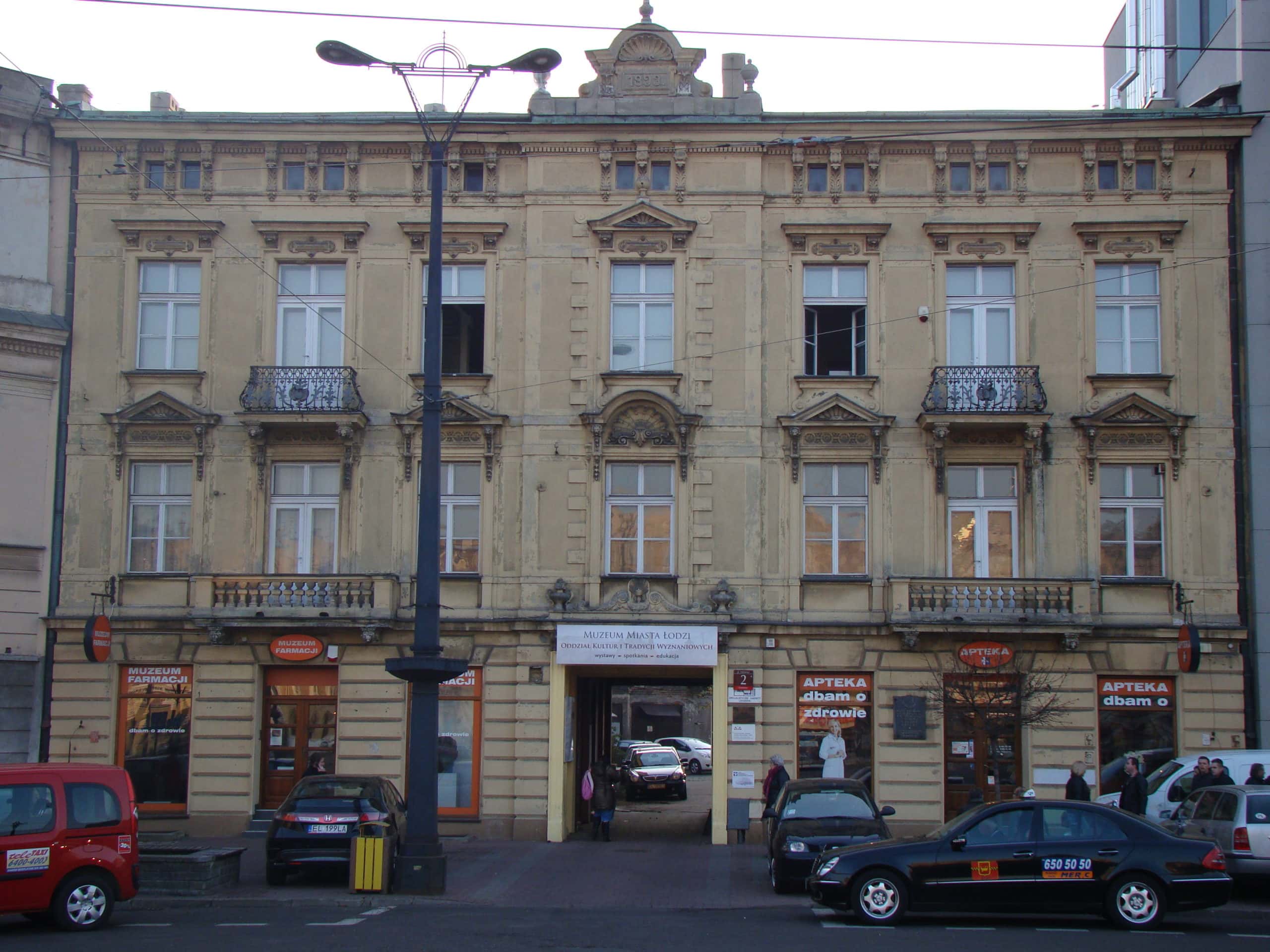
Museum of Archeology and Ethnography in Łódź
The Museum of Archaeology and Ethnography is housed in one of the most historic buildings on Plac Wolności in Łódź.
As previously mentioned, the first school in Łódź, a District Real School, was established in 1856 in the building at present-day Plac Wolności 14. Designed by Jan Karol Mertsching, construction of the building was completed in 1854. Originally, it was a single-storey brick building.
After the District Real School, the Łódź Craft School made use of the building. The Łódź Magistrate also held office in the building for a short time. In 1869, the Łódź Higher School of Crafts – a state secondary technical school – was established here. The studies lasted six years. Graduates were highly valued and usually took up managerial positions in the industrial sector in Łódź.
A reconstruction of the building in 1884, according to the recommendations of Hilary Majewski, allowed for an increase in the number of workshops and classrooms.
In 1899, the school was reformed. From that moment on it was called the Łódź School of Crafts and Industry. The studies were extended to seven years.
Just to summarise the events of 1915 once more. The local council moved their headquarters from the Old City Hall to what had previously been the Łódź Higher School of Crafts and Industry located at Nowy Rynek 14. Unfortunately, the building failed to meet the needs of the city council, and was thus expanded in the years 1924-1925. Therefore, the current building is the result of the vision of not only Hilary Majewski, but also another Łódź architect called Wiesław Lisowski who led the reconstruction in the mid-1920s. Ultimately, the building became an impressive four-storey building in the classicist style.
Located at present-day Plac Wolności 14, the building currently houses the Museum of Archeology and Ethnography, which was formally established on January 1, 1956.
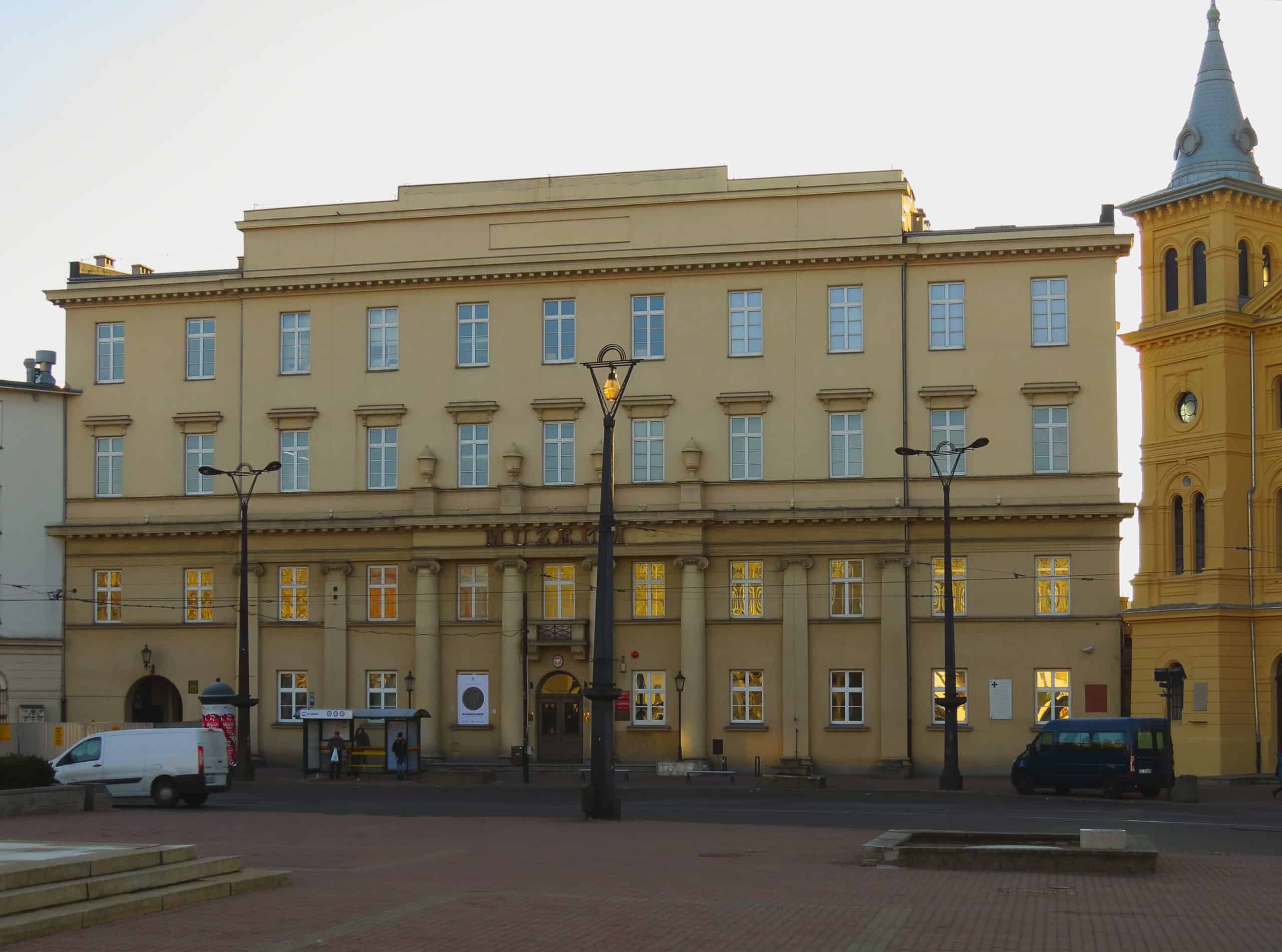
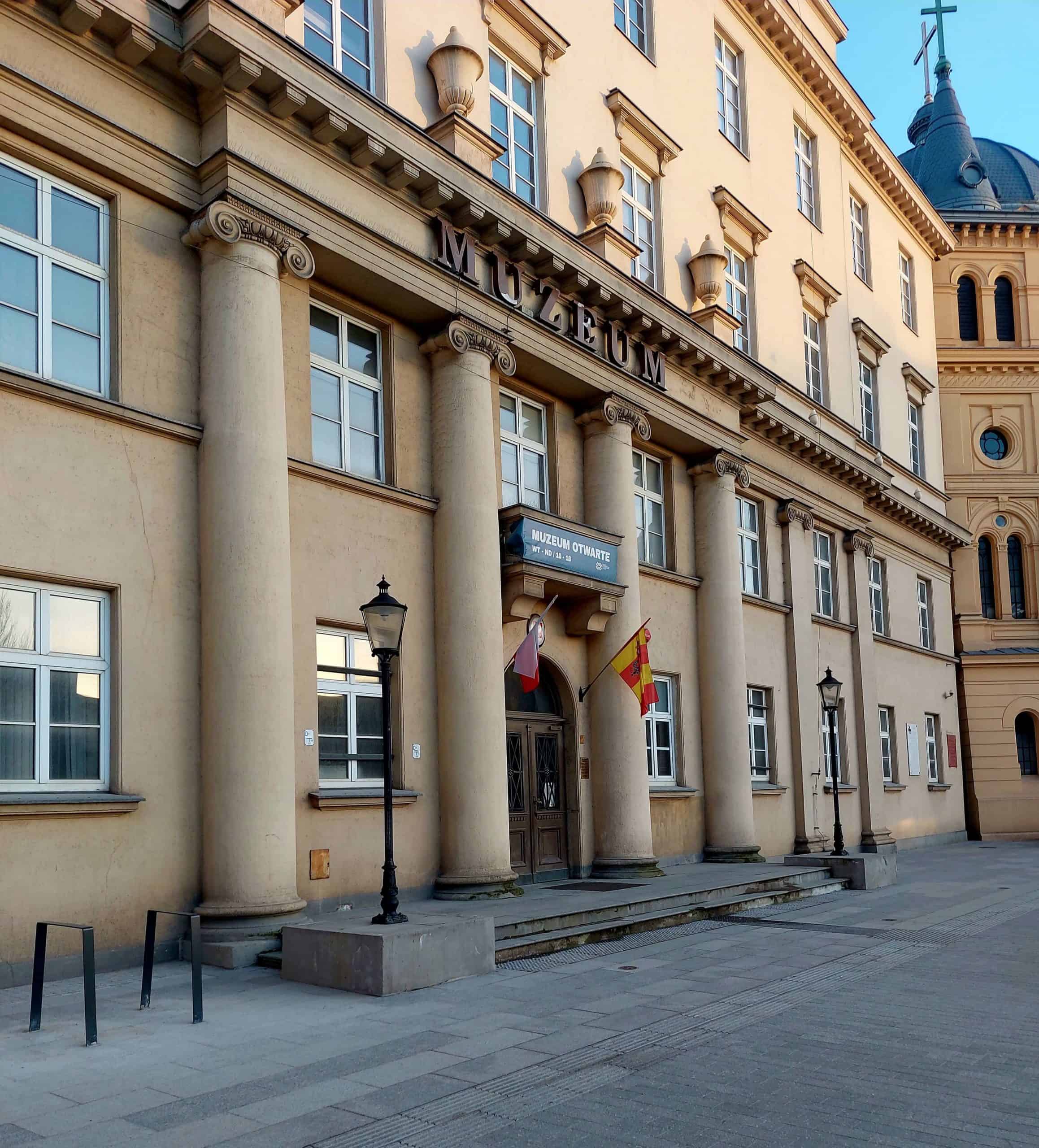
Monument to Tadeusz Kościuszko
One of the most symbolic monuments in the whole of Poland, not to mention on Plac Wolności in Łódź, is the Monument to Tadeusz Kościuszko.
A Brief Overview of the Military Life of Tadeusz Kościuszko
Born on February 4, 1746, Andrzej Tadeusz Bonawentura Kościuszko, otherwise known as Tadeusz Kościuszko, was a Polish military leader. In his role as Supreme Commander of the Polish National Armed Forces, Kościuszko was perhaps most famous for leading the Polish Uprising of 1794 against the Russian and Prussian influence on the Polish-Lithuanian Commonwealth.
In 1776, Kościuszko moved to North America, where he became a colonel in the Continental Army in the American Revolutionary War against the British. It was Kościuszko who conjured up the defensive strategy for the Battle of Saratoga, which proved to be the turning point of the American Revolution. In 1783, in recognition of his services, the Continental Congress promoted Kościuszko to brigadier general.
Monument to Tadeusz Kościuszko on Plac Wolności in Łódź
The striking monument which stands in the centre of Plac Wolności in Łódź has the most surprising origins.
At a City Council meeting on October 15, 1917, the council, which comprised 27 Poles, 25 Jews and 8 Germans, decided to erect a monument to commemorate the 100th anniversary of the death of Tadeusz Kościusko. Kościuszko died on October 15, 1817. The staggering element of the meeting was the fact that the First World War was still ongoing and Łódź was ruled by German occupiers.
Originally, councillors wanted to erect the monument at the intersection of Kościuszki Avenue (formerly Spacerowa, and also named after Kościuszko) and Andrzeja Struga Street (formerly St. Andrzeja Street). Ultimately, however, it was decided that the monument would be placed on Wolności Square.
The design by the sculptor and engineer Mieczysław Lubelski was selected for implementation in January 1926. On May 3, 1927, the cornerstone for the monument was laid. The final unveiling of the monument took place on December 14, 1930.
The Germans demolished the monument on November 11, 1939. After World War II, the local authorities in Łódź decided to rebuild the monument. Mieczysław Lubelski was once again asked to create it. Łódź artists Elwira and Jerzy Mazurczyk and Antonii Biłas were also invited to participate in the project. The ceremonial unveiling of the Tadeusz Kościuszko monument took place on July 21, 1960.
A statue, approximately four metres high, was placed on a thirteen-metre-high pedestal. It depicts Kościuszko holding a roll of the “Proclamation of Połaniec” text (see below for information) in his left hand. His right hand is protecting an oak tree – a symbol of freedom. Kościuszko has a sabre on his left side, and a knight’s armour and a small cannon rest at his feet.
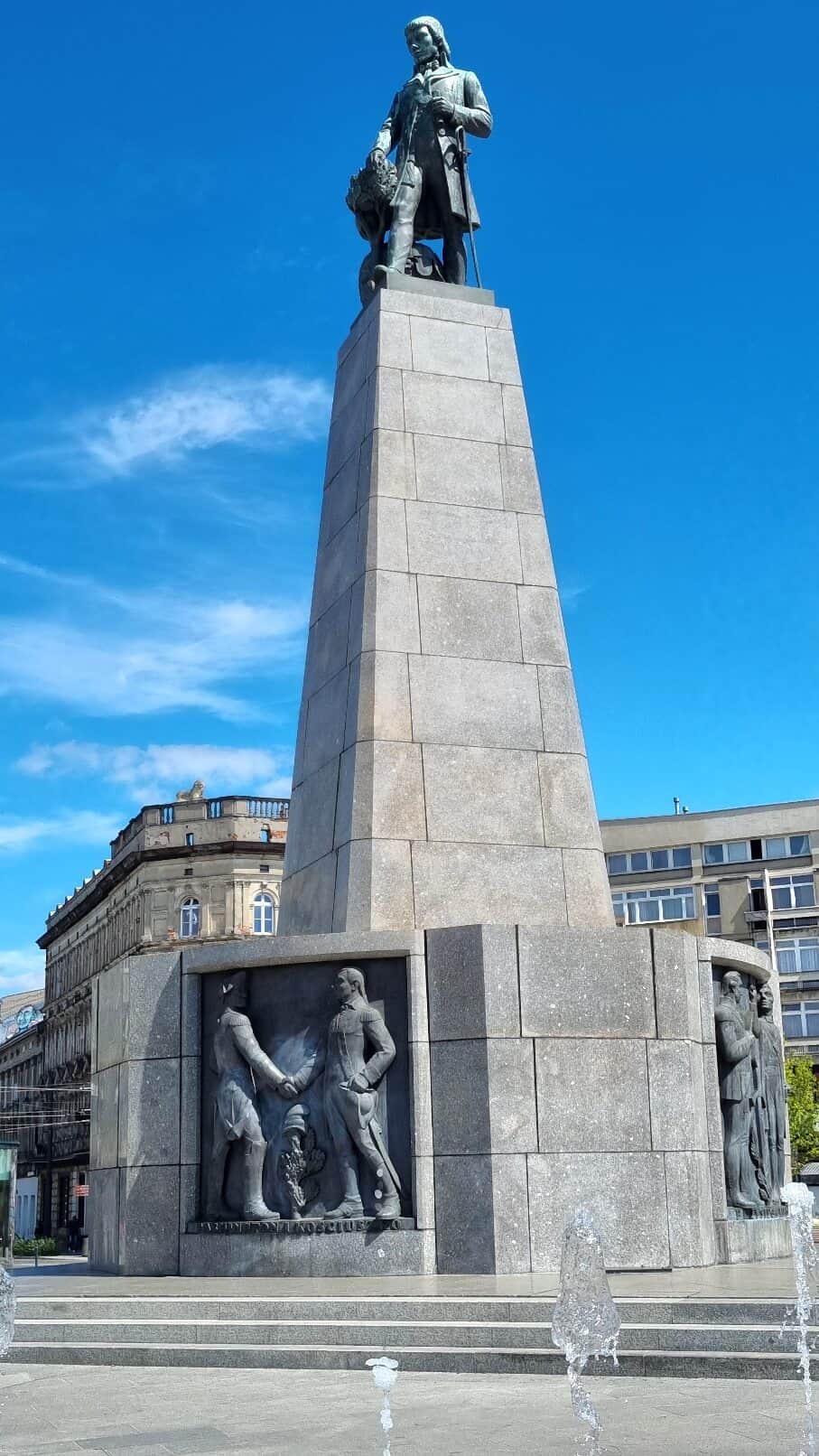
Bas-reliefs on the Pedestal of the Monument to Tadeusz Kościuszko
Carved into the walls of the octagonal plinth of the pedestal of the Monument to Tadeusz Kościuszko, there are four bronze bas-reliefs which depict momentous events from the military leader’s life:
1. George Washington and Kościuszko
Tadeusz Kościuszko was very much respected by the commander-in-chief of the Continental Army in the American Revolutionary War, George Washington.
From March, 1778, Kościuszko designed the defensive fortifications surrounding West Point, New York, to protect against British assaults. Washington held the view that West Point was the most strategically important military post in America.
In 1780, General George Washington heaped praise on Kościuszko for the impressive fortifications. Consequently, Washington granted Kościuszko his wish to return to active frontline command in the Southern theatre of the war.
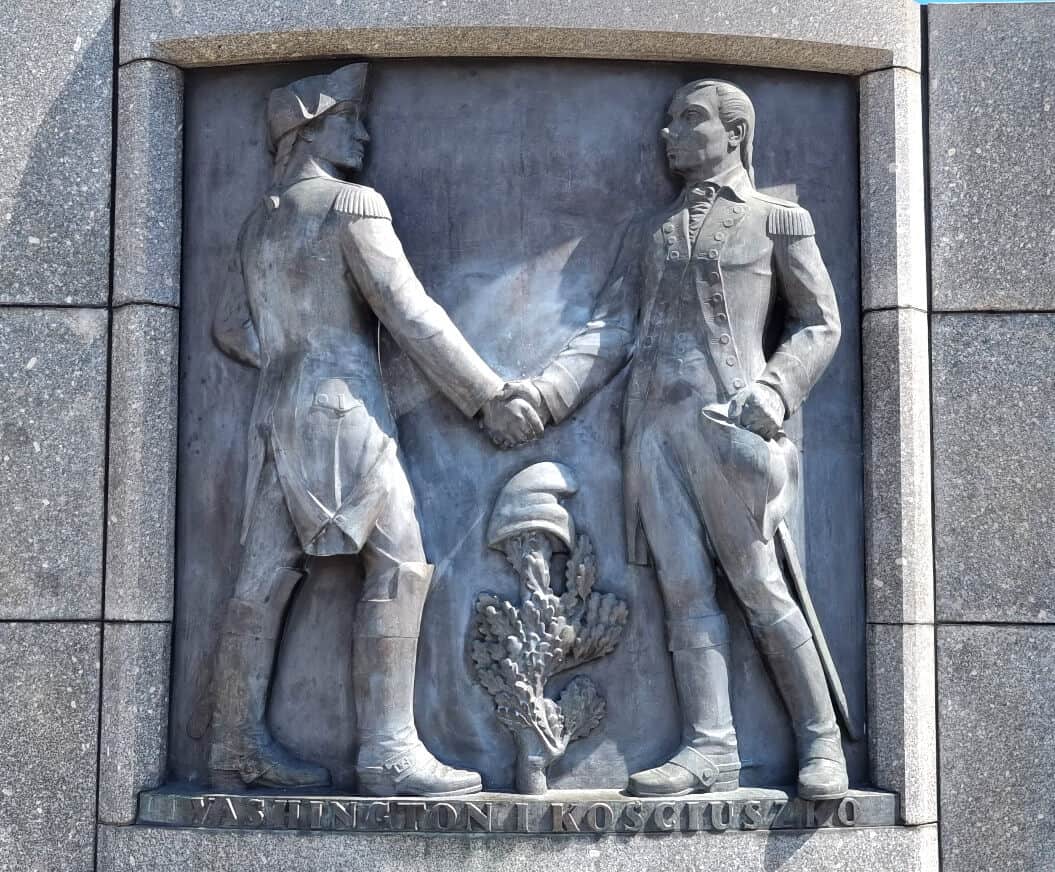
2. Kościuszko’s Oath in the Main Square in Kraków
On 24 March 1794, Kościuszko, nominated as the commander-in-chief of the National Armed Forces, took an oath before the military, clergy, townspeople, and peasants gathered in the main marketplace in Kraków. Kościuszko swore that he would use the powers invested in him to protect the borders of the Commonwealth, in addition to regaining and strengthening its freedom.
Kościuszko’s oath:
❝ I, Tadeusz Kosciuszko, swear before God to entire Polish Nation that I will not use the power invested in me for private gain or oppression, but solely for the defence of the integrity of the borders, the restoration of self-determination of the Nation and the establishment of liberty for all. So help me God and the innocent suffering of his Son.❞
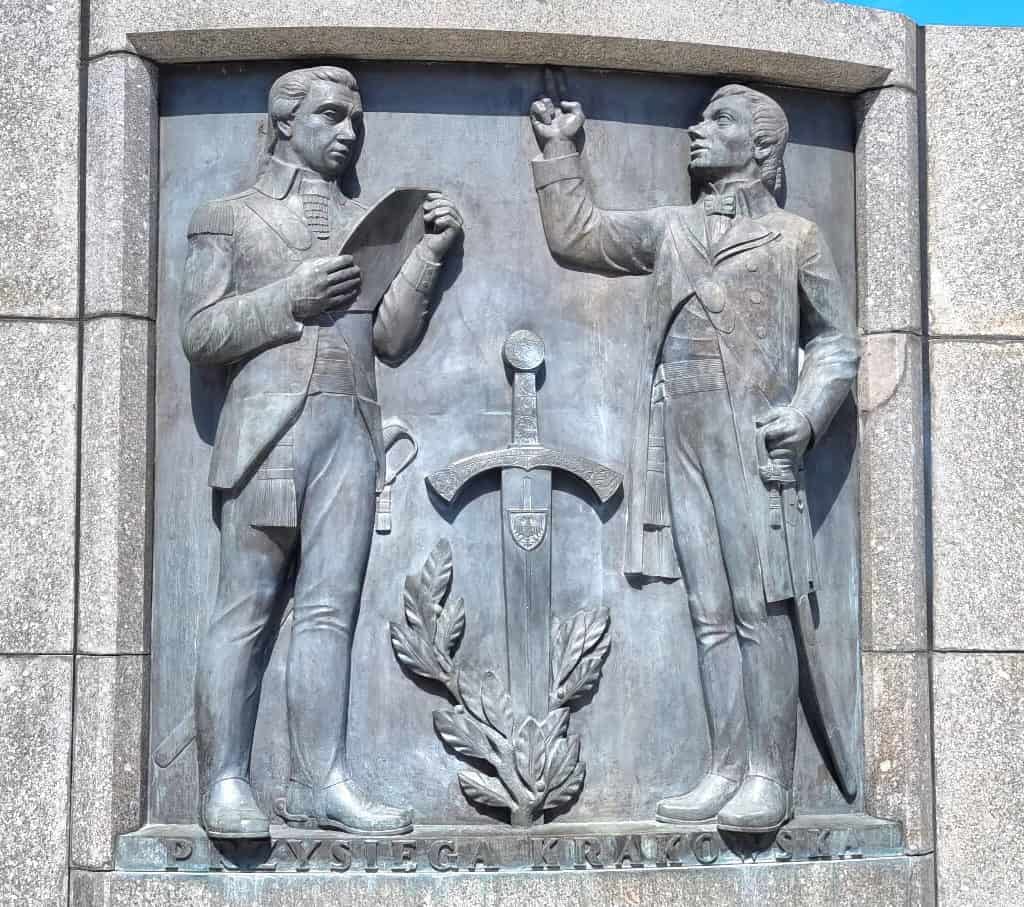
3. Kościuszko and Wojciech Bartosz Głowacki
Wojciech Bartosz Głowacki was a Polish peasant and one of the most famous soldiers belonging to the kosynierzy (peasant volunteer infantry) during the Kościuzko Uprising in 1794.
Głowacki’s claim to fame was his role in the battle of Racławice on April 4, 1794. Bartosz was the first to reach Russian enemy lines. Extraordinarily, he prevented one of the enemy cannons from shooting by putting out its fuse with his cap. For that particular deed, in addition to his pro-uprising rhetoric, Kościuszko promoted Bartosz to the rank of standard-bearer (chorąży) in the newly-formed regiment called Grenadierzy Krakowscy, or the Kraków Grenadier Regiment.
There were further perks in store for Bartosz as received the surname ‘Głowacki’ and was released from serfdom. He also gained the right to own land.
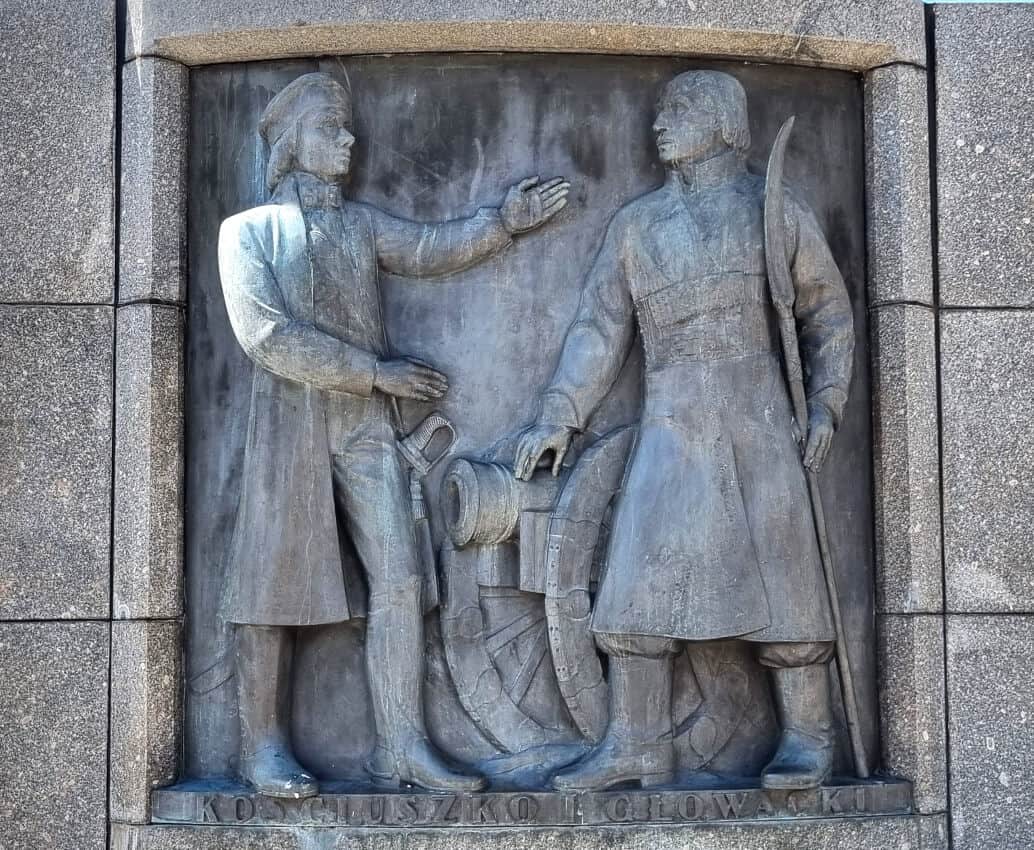
4. “Uniwersał połaniecki” – Proclamation of Połaniec
One of the most significant events of Poland’s Kościuszko Uprising was Kościuszko’s “Proclamation of Połaniec”. Issued on May 7, 1794 near the town of Połaniec, the proclamation was the most famous legal act of the Uprising.
Essentially, Kościuszko sought to abolish serfdom in Poland as well as to grant substantial civil liberties to peasants. In reality, the Manifesto had little impact on the actual situation of peasants in Poland. The main reason for its publication was to legalise the scythemen units and enable the peasants to fight in armed combat as part of the insurgent army against Prussia.
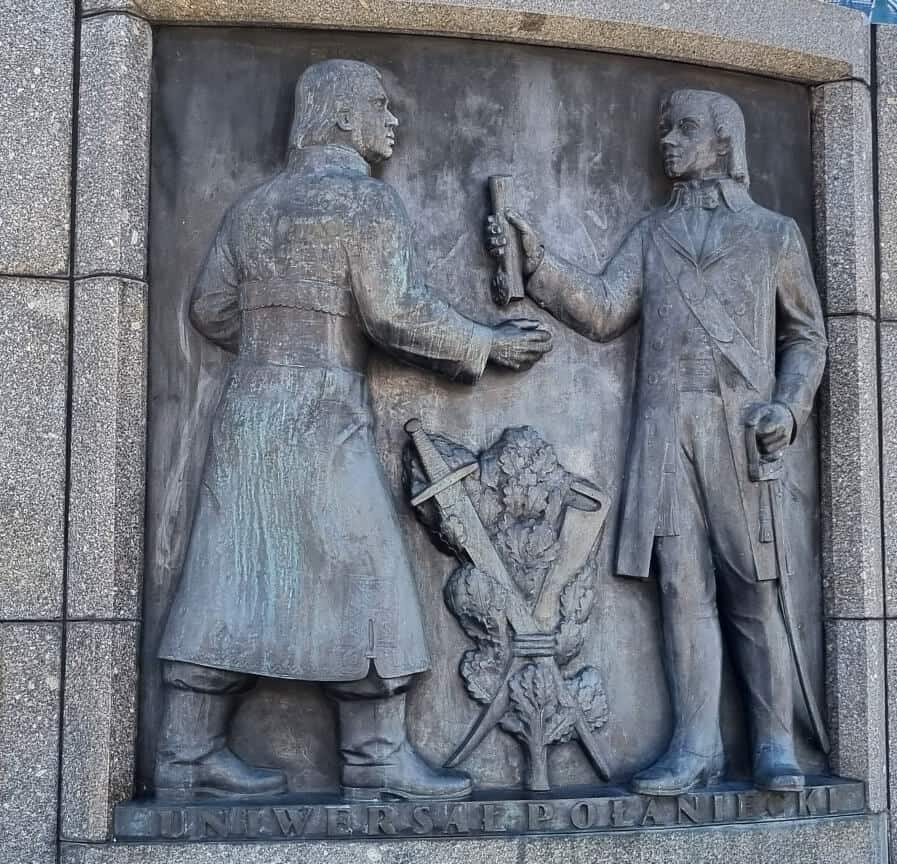
The Reconstruction of Plac Wolności in Łódź
The reconstruction of Łódź’s historic Freedom Square ended in February 2024, with the public invited to admire the results of the renovation on March 2, 2024. This project was part of a broader programme to regenerate the city centre of Łódź.
There is no longer a roundabout on the square. All road communication has been moved to the northern side of Plac Wolności. Trams and cars can pass from Pomorska Street to Nowomiejska Street and Legionów Street. Public transport stops were moved to a single area so that passengers can easily change from buses to trams and vice versa. There are four shelters for users of public transport.
One of the most notable changes on Plac Wolności is the amount of greenery the square now has. 64 trees, shrubs and other low plants were planted. There are also several lawns which are consistently watered.
In the northern and southern parts of the square, fountains in the form of sprinklers hidden in the surface were created. There are also 58 new benches, 18 waste bins, 81 bicycle racks, a play area for children and a range of new lighting poles and street lighting fixtures.
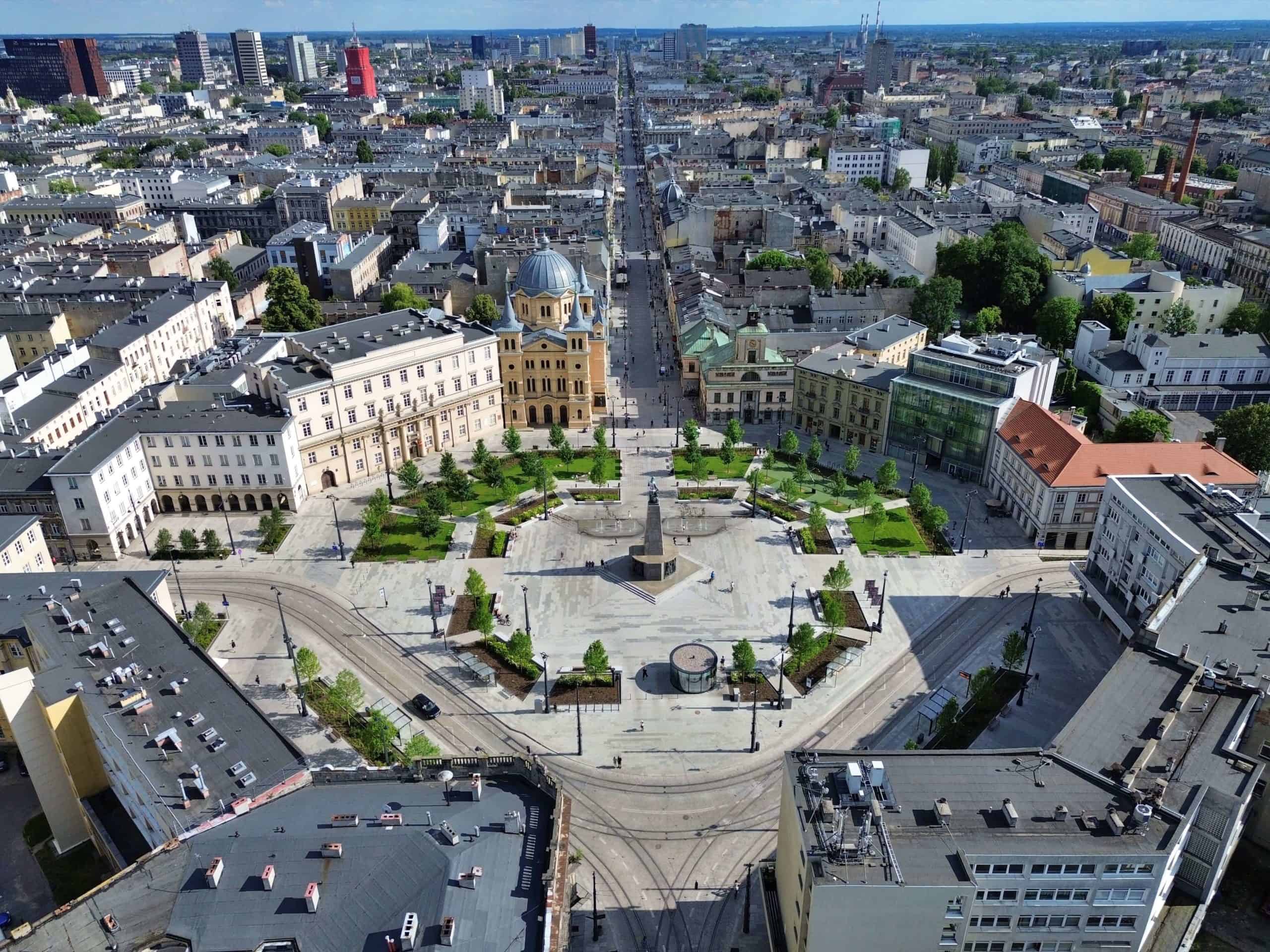
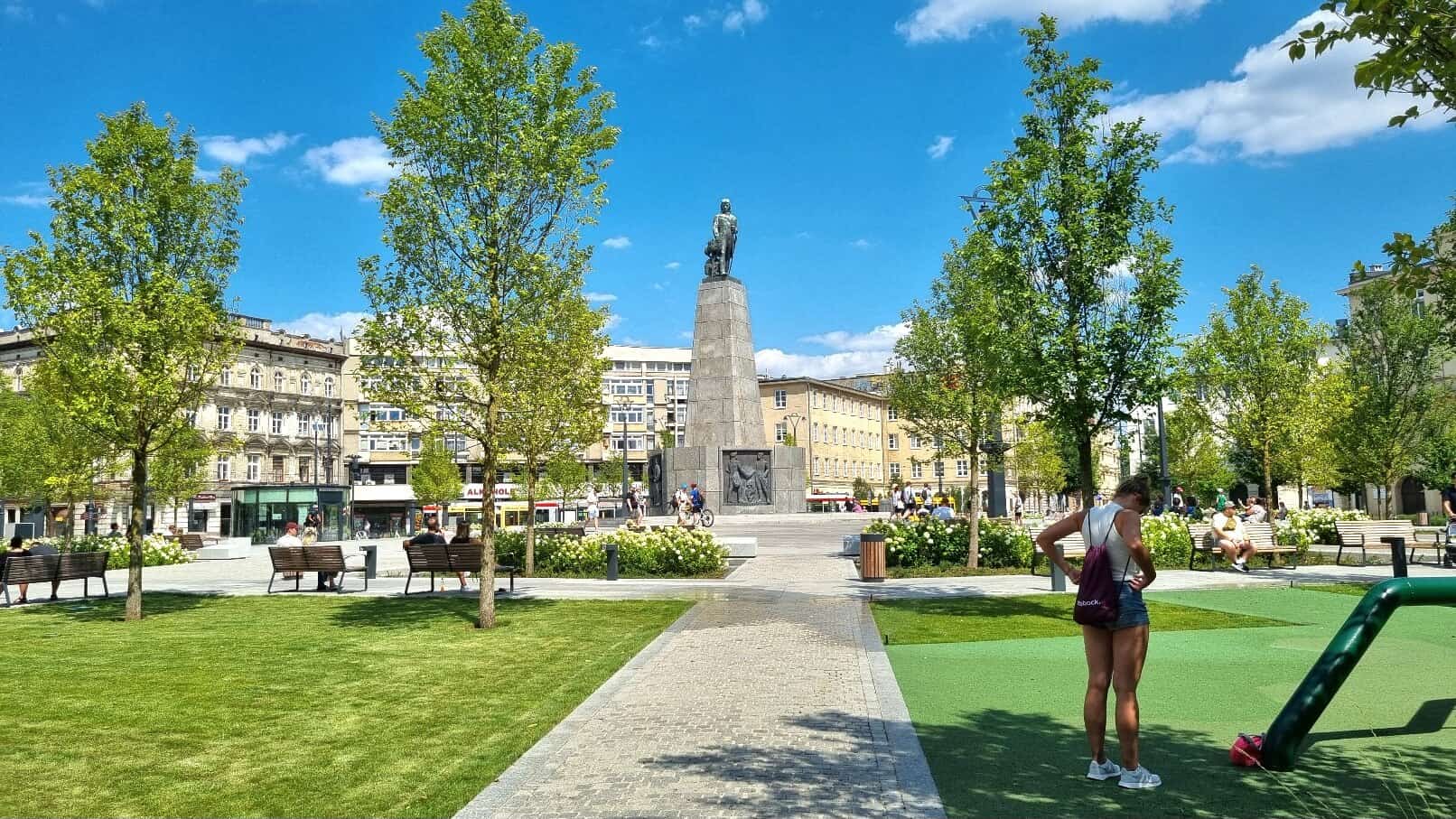
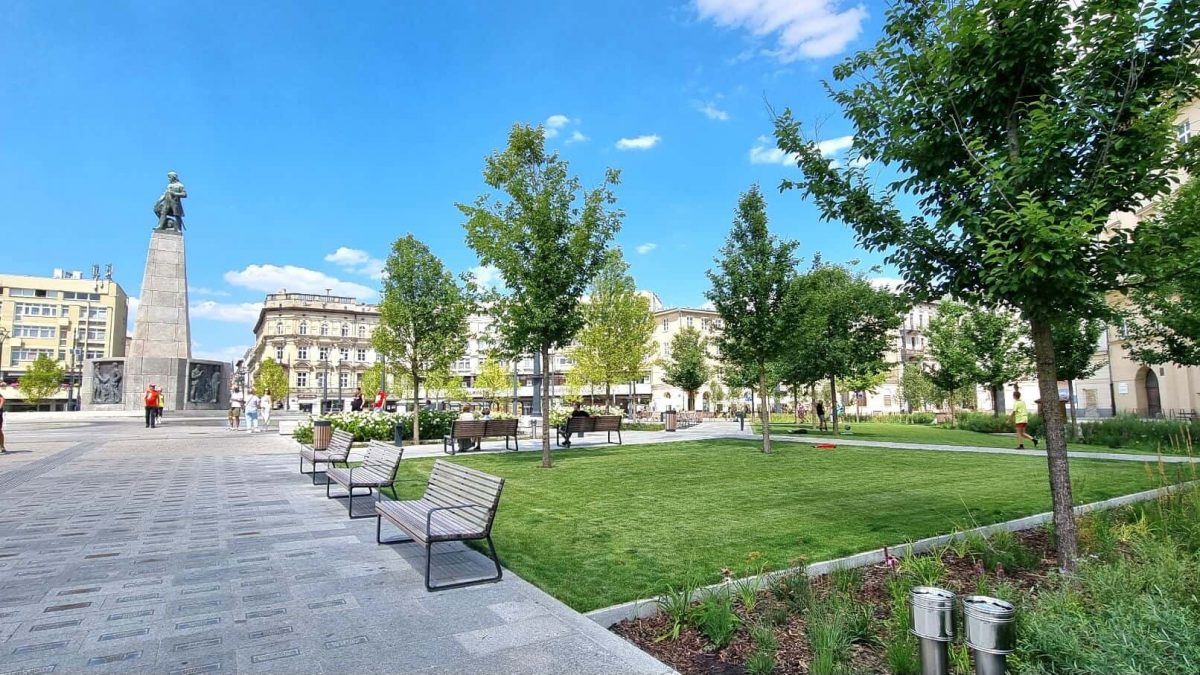
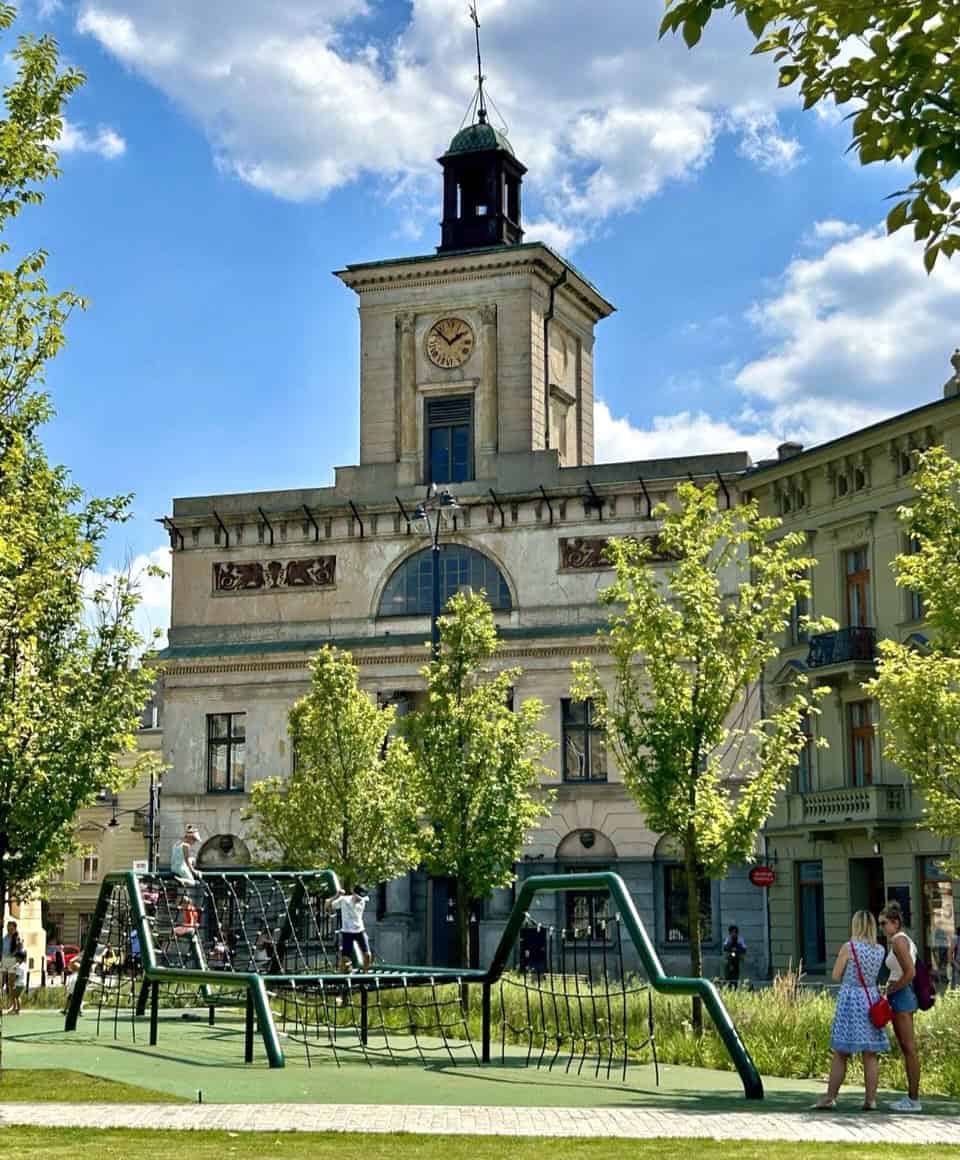
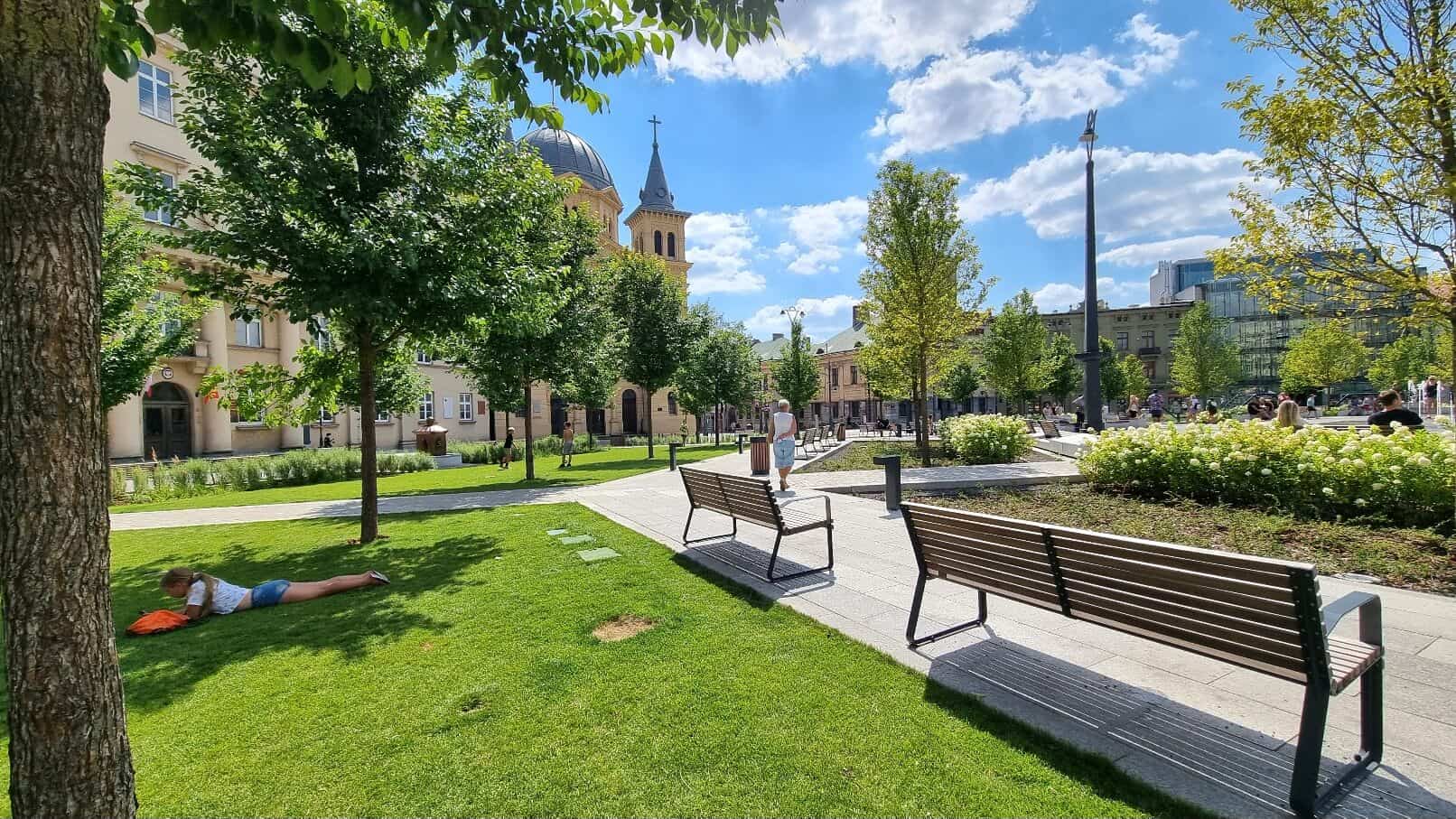
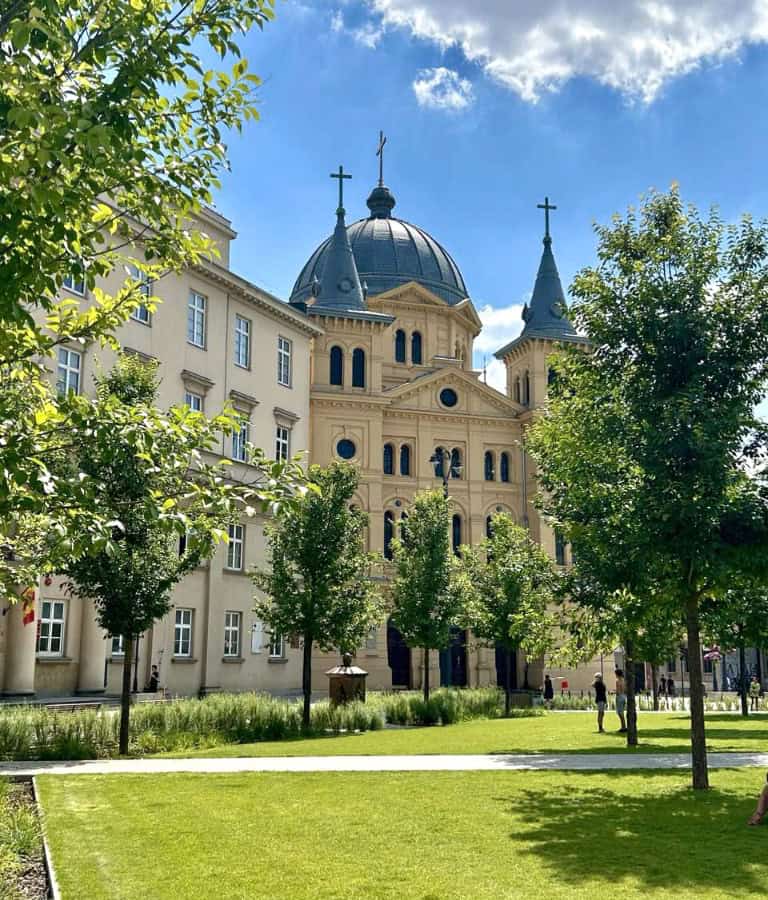
Final Thoughts
Compared to how I remember Plac Wolności when I lived in Łódź between January 2012 and June 2013, the square is virtually unrecognisable.
I think it’s important to see the square for its historical significance and the number of attractions it contains. I’ve already mentioned some of the main places of interest and museums. There’s also a unique tourist attraction which allows visitors to walk through a small disused section of a sewer. This is known as the Dętka “Sewer” Museum (Muzeum Kanału “Dętka”),

